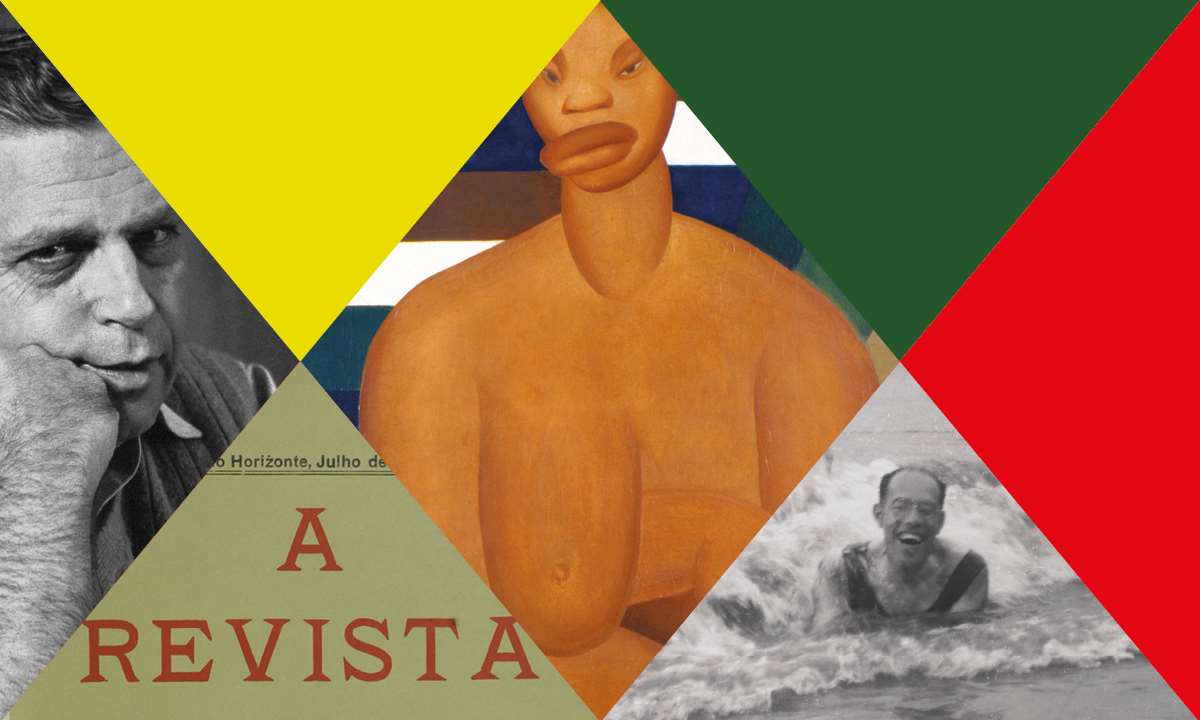The Week of Modern Art, held in February 1922 at the Municipal Theater of São Paulo, continues to challenge researchers dedicated to understanding its transforming impact on the arts and literature of Brazil, even a century after the fact. There are two predominant lines of analysis. One entails investigation into the unknown particulars regarding the authors and well-known works connected with the event, which has been widely studied over the last century. The other takes a critical look at the movement’s historiography, seeking to put “The Week” into a larger perspective. Though complementary, the two currents compete for space in reconstructing the cultural memory of Brazilian Modernism.
A collective movement intended to stimulate the development of new aesthetic ideals in the arts and literature, the Week of Modern Art sought to break with cultural traditions associated with the teachings of the Escola de Belas Artes (School of Fine Arts) in Rio de Janeiro and with trends such as symbolism and Parnassianism, which were marked by characteristics such as the use of strong metre, cultured language, and historical themes. The event inspired around a hundred works of art, in addition to literary and musical soirees. Influenced by the European avant-garde, among the participants were intellectuals such as the painter Anita Malfatti (1889–1964), sculptor Victor Brecheret (1894–1955), and writers Mário de Andrade (1893–1945), Oswald de Andrade (1890–1954) and Graça Aranha (1868–1931), (who was also a diplomat). “As much as The Week was an event situated in time and space, what we have now is, above all, its myth, that is, a narrative of the origin or emergence of a cultural movement. In this sense, we can say that The Week, as a historical fact and mythical landmark, is as full of meanings as any good work of art, continuously stimulating new attempts at understanding,” observes Eduardo Sterzi, a professor of literary theory at the University of Campinas (UNICAMP).
Philosopher Luiz Armando Bagolin, of the Institute of Brazilian Studies at the University of São Paulo (IEB-USP), points out that the idea that the Week of Modern Art was the origin of modernism in Brazil was constructed between 1937 and 1945, with the establishment of the Estado Novo by Getúlio Vargas (1882–1954). “The government realized that some modernist policies, such as glorifying the national identity, were useful to state rhetoric. Thus, there was a Vargas policy committed to co-opting intellectuals to work for the government,” Bagolin says. He points out that in 1953 Vargas made a speech to the nation not only praising the movement, but also associating it with the desire to modernize society and the need for the country to achieve material and industrial progress. “With that, a history of Brazilian modernism was built up as a singular entity seen through a positive lens,” he adds. Bagolin believes this was the prevailing view in the first academic studies on the movement, which were conducted during the 1970s when the São Paulo state government acquired the Mário de Andrade collection, and the family donated his archive to the IEB. “Until the 1990s, a common denominator of studies developed within literary theory and in the social sciences was to treat the modernists as a single, cohesive group, with a reverent tone,” the philosopher observes.
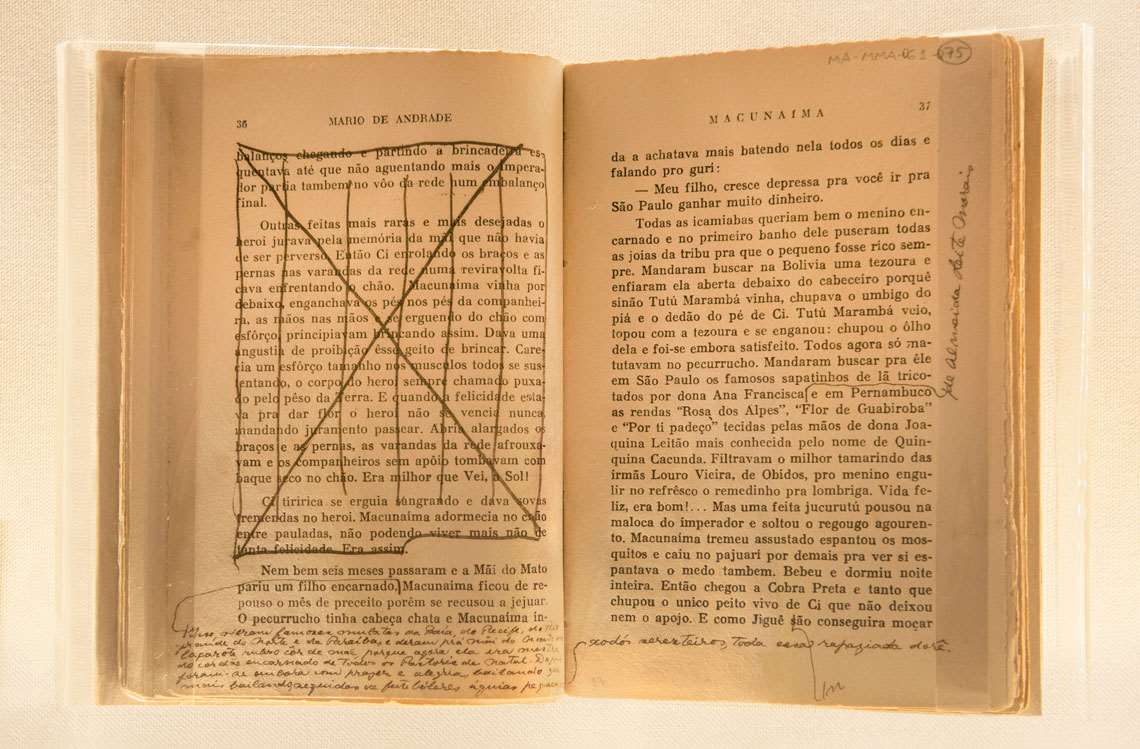
IEB-USP, Mário De Andrade Fund, reference code: MA-MMA-061-056-201 / Léo Ramos ChavesA 1944 copy of Macunaíma, which was being revised by Mário de AndradeIEB-USP, Mário De Andrade Fund, reference code: MA-MMA-061-056-201 / Léo Ramos Chaves
Recognized for her studies on Mário de Andrade, USP literature researcher Telê Ancona Lopez explains that, despite this trend, within the fields of literary theory and Brazilian literature at the School of Philosophy, Languages and Literature, and Human Sciences (FFLCH) at USP, theses and dissertations had already been conducted that identified a variety of projects involving modernism. She also considers the 1970s to be a milestone in academic reflection on modernism, because, in addition to the IEB, other institutions began to organize archives for modernist authors during this period, including the Alexandre Eulalio Cultural Documentation Center (CEDAE), at UNICAMP, and the Fundação Casa de Rui Barbosa. She observes that over the following decade, genetic criticism, propagated in Brazil by Philippe Léon Marie Ghislain Willemart (also from USP), encouraged the production of more exacting manuscript editions. Genetic criticism is a methodological field in literary theory that seeks to reconstruct the process of a work’s development based on analyzing texts that preceded it. “In the 2000s, Brazilian literary research was characterized by the search for data in primary sources. It was a change in method that added value to building the historiography and to the editing of modernist texts and seeks to faithfully portray the writer’s project. This was a lesson taught by sociologist and literary critic Antonio Candido [1918–2017],” says Lopez.
As a part of this movement, from 2006 to 2011 the researcher coordinated a project aimed at analyzing the creative process of Mário de Andrade, with FAPESP support. The research was developed based on manuscripts located in the writer’s archive, which includes his collected correspondence. “For example, during the investigation we were able to discover the dialogue that the author formed with Parnassianism, despite the distance that modernism sought to establish from this literary movement,” she points out. In 2000, the IEB and EDUSP launched the Mário de Andrade Correspondence collection, an editorial project that has since published his letters. “The initiative set an editorial milestone by making it possible to see within this epistolary dialogue the presentation of modernism by Andrade himself.” For 2022, the publication of the volume Correspondência Mário de Andrade & Oswald de Andrade is planned, organized by Gênese Andrade, a literary researcher and professor at Fundação Armando Álvares Penteado (FAAP).
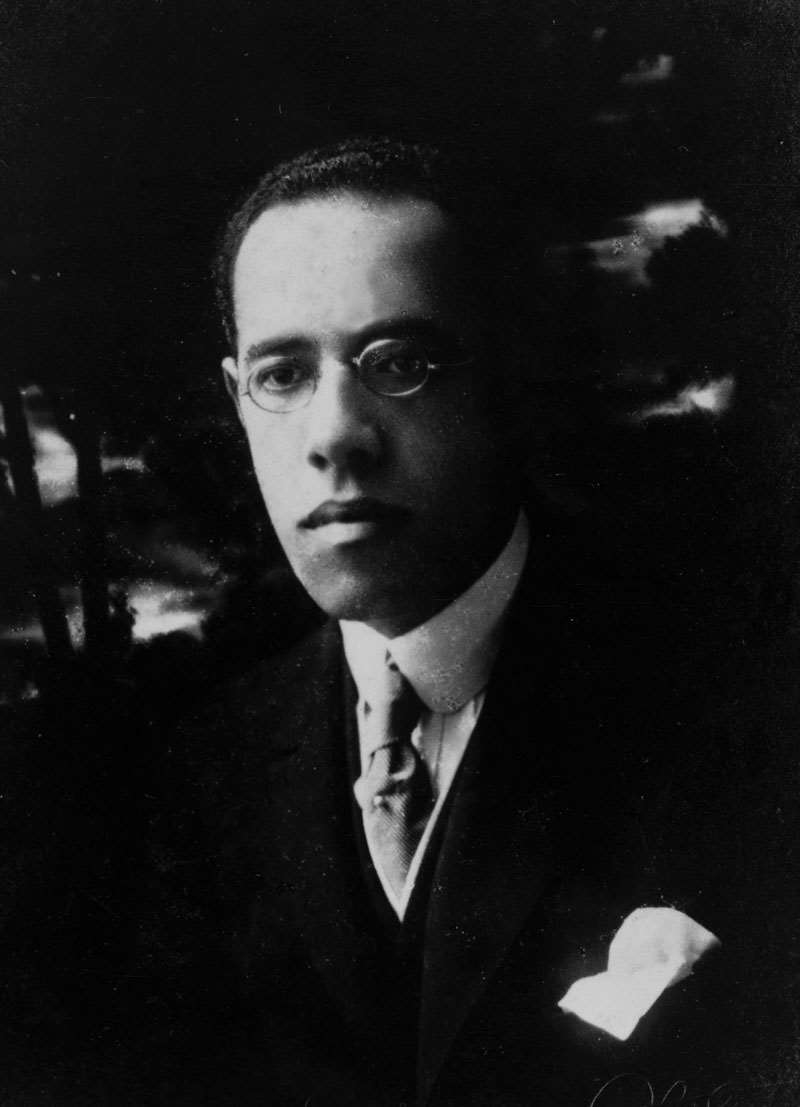
IEB-USP, Mário De Andrade Fund, reference code: MA-F-0015Mário de Andrade in 1917IEB-USP, Mário De Andrade Fund, reference code: MA-F-0015
Research on manuscripts of the time has brought to light aspects of the modernist authors that were hitherto unknown. Edited by Jorge Schwartz, a retired professor of Spanish-American literature at USP, and published in late 2021, his book Oswald de Andrade: Obra incompleta (Incomplete work) (EDUSP/Archivos) is the result of a project begun in 1985. The book, which received funding from FAPESP, gathers the author’s poetry, fiction, critical discussions, and manifestos, in addition to reproducing unpublished manuscripts that give a behind-the-scenes look at literary production. “The book’s preparation involved searching for documents with specialists, heirs, family members, collectors, and in the IEB archives, where the Andrade collection was held for years, until it was transferred to CEDAE at UNICAMP,” Schwartz says. “The disperse, fragmentary, and almost chaotic state of what remained of Oswald de Andrade’s documentary heritage reveals an intellectual personality averse to the methodology of filing cabinets or to the systematic preservation of the various stages of his own production process… It was an attitude typical of the detachment, spontaneity, and naiveté of an author who never suspected that he would become one of our most extraordinary literary figures, the most radical of the modernists, a perpetual revolutionary,” Schwartz writes in the introduction to the work, which comprises two volumes and more than 1,600 pages.
Gênese Andrade, who was in charge of researching, reviewing, and preparing the book’s notes, was also responsible for mapping and analyzing Oswald de Andrade’s poetry manuscripts. For example, during the project she found that the poem O santeiro do Mangue was started in 1936 and rewritten at least 16 times, until finally being completed in 1950. “The author’s poetry gives the impression of spontaneity, but his manuscripts reveal an enormous effort at refinement, until he achieved an apparently simple result,” Andrade notes. In her view, the study of such documents allows us to rethink Oswald de Andrade’s role in the literary scene of his time. She says critics tend to see Mário de Andrade as a “focused and studious” author, while Oswald de Andrade has been relegated to the role of an unserious intellectual. “However, when we accessed his manuscripts, we found that this wasn’t true,” she notes. As a result of investigations begun over 20 years ago, Gênese Andrade is also wrapping up Arte do Centenário (1920-1922) –Oswald de Andrade, a book to be released in 2022 by Universidade Estadual Paulista (UNESP) publishing. The work brings together 19 Oswald de Andrade texts released in the press between 1920 and 1922, 10 of them never published in book form.
Another trend in recent research on modernism includes studies that take a biographical perspective. Along this vein are a biography of Tarsila do Amaral (1886–1973), written in 1997 by Nadia Battella Gotlib, a retired professor at USP, and a biography of Mário de Andrade, published by journalist Jason Tércio in 2019. “The publication of the life history of great intellectuals represents a sign of maturation of the cultural scene. Reliable biographies are important tools for critical reflection, because they help readers to place the works in time with greater accuracy,” observes Sterzi, of UNICAMP.
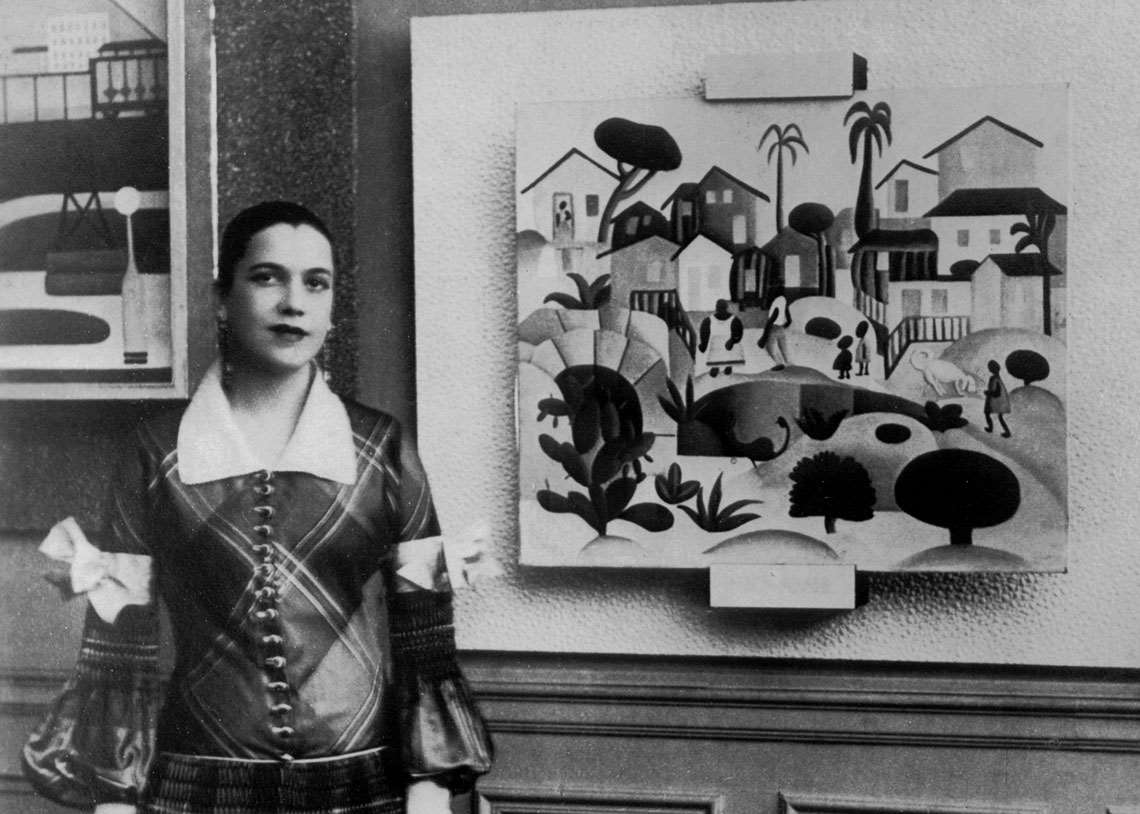
IEB-USP (Schwartz, Edusp: 2021) Below, Tarsila do Amaral in 1926 during an exhibition of her work, held at Galerie Percier, in ParisIEB-USP (Schwartz, Edusp: 2021)
Archival analyses permit a glimpse behind the scenes of important events in the history of modernism. In her diary, for example, Anita Malfatti recounts that on the way to her first solo exhibition, organized in 1914 in downtown São Paulo, she bought new shoes without trying them on. The shoes were too small, and she ended up walking into the gallery barefoot. The artist also reports in her diary that, in 1917, at a solo exhibition staged after she had spent some time in the United States, Mário de Andrade was one of the first to show up. He arrived soaked by the rain, stopped in front of the artworks and burst out laughing. A few days later, the writer returned to the exhibition, introduced himself as a poet and announced his intention to buy the painting The Yellow Man.
The painter’s diary, which is part of the IEB collection, is being exhibited for the first time to the public at the exhibition Era uma vez o moderno (1910–1944) (Once upon a time, the modern). Organized by Bagolin, the show is based on research conducted over a year-and-a-half period with collaboration from historian Fabrício Reiner, an independent curator. Through a partnership between the Cultural Center of the Federation of Industries of the State of São Paulo (FIESP)—which is hosting the event—and the IEB, the exhibition brings together more than 300 works and documents, including the diaries, letters, manuscripts, photos, and paintings of intellectuals who took part in initiatives involving Brazilian modernism from 1910 to 1944. These include Mário and Oswald de Andrade and Tarsila de Amaral from São Paulo, the Pernambuco poet Manuel Bandeira (1886–1968) and painters Cícero Dias (1907–2003), also from Pernambuco, Ismael Nery (1900–1934) from Pará, and Di Cavalcanti (1897–1976) from Rio de Janeiro. Bagolin explains that the goal of the exhibition, on display through May, is to highlight the human dimension of the intellectuals who participated in the debate surrounding the possibilities for creating modern art in Brazil.

1 and 2 Biblioteca Brasiliana Guita and José Mindlin, University of São Paulo IEB-USP, Mário de Andrade Fund, reference code: MA-PLM-0002 / Léo Ramos Chaves 1. Cover of Há uma gota de sangue em cada poema (There is a drop of blood on each poem), the first book published by Mário de Andrade, in 1917 2. Inaugural edition of the journal Klaxon, published in May 1922 to promote modernist production 3. Leaflet with the schedule for the second day of the Week of Modern Art1 and 2 Biblioteca Brasiliana Guita and José Mindlin, University of São Paulo IEB-USP, Mário de Andrade Fund, reference code: MA-PLM-0002 / Léo Ramos Chaves
With this project the IEB intends to present researchers’ reflections on the Week of Modern Art within the context of a historical process that began before 1922 and saw subsequent developments, Bagolin says. “We want to understand how the modernists themselves envisioned the history of the movement. Original sources demonstrate the existence of a diversity of positions and initiatives that sought to introduce modern art and literature in Brazil,” the philosopher adds. He contrasts this view with the idea of a singular modernism, composed of a cohesive group united around the same ideals.
One of the aspects of the movement that has triggered critical discussions involves the idea of anthropophagy. Coined by Oswald de Andrade and Tarsila Amaral in 1928 as one of the repercussions of “The Week,” anthropophagy proposed an artistic development based on the devouring and assimilation of differing cultures, especially indigenous ones. A scholar on the subject for almost a decade, Sterzi classifies it as a criticism of the initial moments of modernism, which, according to him, “presented futurist and nationalist enthusiasms devoid of serious consistency and, often, only referential to the official point of view.” “With the Manifesto Antropófago (Anthropophagous manifesto), Oswald de Andrade cuts through modernism, proposing a revolutionary political ontology based on Tupinambá ritual anthropophagy,” he analyzes. Sterzi explains that in the anthropophagic conception the indigenous is not invoked as it was in romanticism, that is, as a precursory figure of national identity. He believes that, for Andrade, transforming an indigenous person into a Brazilian represented a form of violent capture, which destroyed their uniqueness. “To counter this, the writer proposed to ‘turn into an Indian’, the title of an article (Virar Índio) published in 1946 and marked by the experience of the Second World War, that is, by the collapse of Western civilization and faith in modernity,” Sterzi points out. The researcher maintains that if the modernism of 1922, to some extent, developed according to a Western logic in its thinking, “anthropophagy came to blow up this conception of the country and its history.”
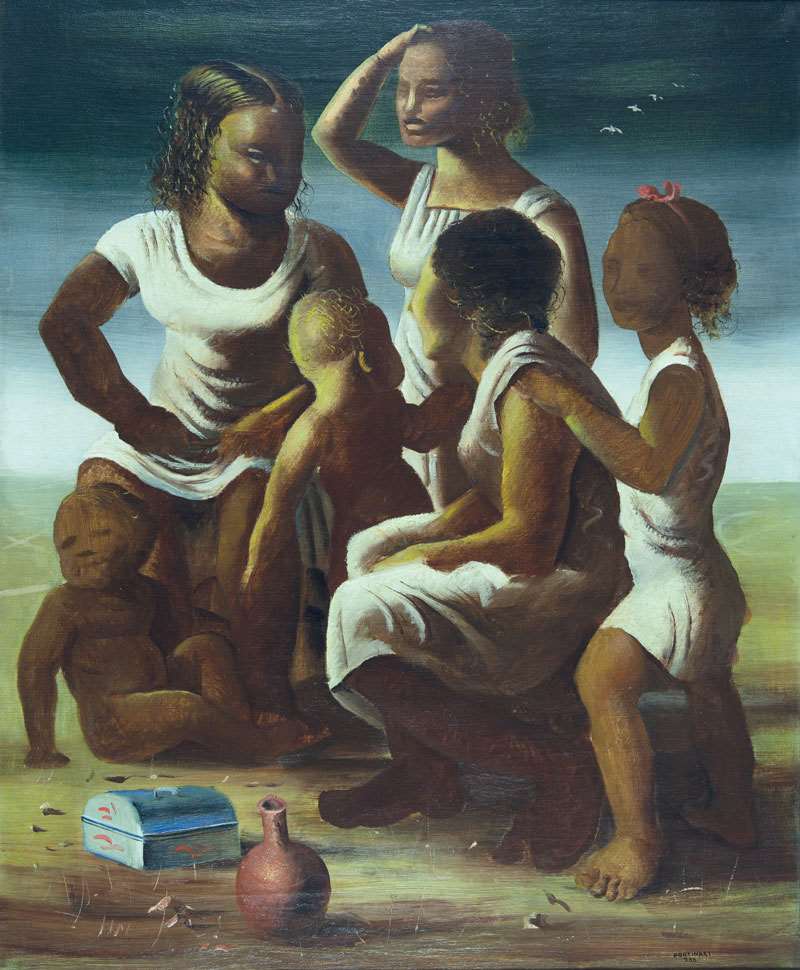
Reproduction rights kindly provided by João Candido Portinari / Coleção de Artes Visuais / IEB-USPComposição (Retirantes), by Cândido Portinari (1903–1962), painted in the 1940sReproduction rights kindly provided by João Candido Portinari / Coleção de Artes Visuais / IEB-USP
Bagolin, at IEB, also sees in anthropophagy a crucial moment to illustrate the diversities of positions and aesthetic ideals in play when analyzing the consequences of the Week of Modern Art. Along these lines, the exhibition on display at the FIESP Cultural Center features a letter written by Mário de Andrade to Tarsila Amaral that clarifies the reasons for the poet’s rift with Oswald de Andrade. The separation came as the result of personal conflicts over Oswald’s comments about Mario’s sexuality. According to the correspondence, their disagreements escalated in 1927, when Mário began to travel throughout Brazil, especially to the Amazon and the state of Rio Grande do Norte, experiences that resulted in the books Clã do Jabuti (Jabuti Clan), released in 1927, and Macunaíma, in 1928. “In his letters to Manuel Bandeira, Mário said that the aesthetic appropriations made by anthropophagy were insufficient to account for the profound Brazil he was getting to know on his travels,” Bagolin observes. In his view, Mário de Andrade was uncomfortable with the use, in anthropophagic texts, of indigenous languages to scandalize and make jokes at the expense of the São Paulo elite. “From this perspective, we can say that Mário already had a decolonizing way of thinking, although this is different from the concept of ‘decoloniality,’ which from the late 1990s onwards began to question the Eurocentric configuration of the world and production of knowledge,” he argues.
For Bagolin, further evidence of the diverse positions among authors who participated in the Week of Modern Art can be found in the last letter written by Mário de Andrade to Manuel Bandeira, in 1944. In the letter, which the writer never sent to Bandeira, he expresses his concern regarding the involvement of modernist intellectuals with the Estado Novo. Vargas’ cultural policy included, for example, appointing Manuel Bandeira to preside over the Salão Nacional de Belas Artes, and architect and urban planner Lúcio Costa (1902–1998) to direct the Escola Nacional de Belas Artes, and inviting poet Carlos Drummond de Andrade (1902–1987) to work at the Ministry of Education (MEC). “In this manuscript, Mário states that he would like to write political epigrams criticizing the government, but he has no more strength, and suggests that Bandeira do so. It’s a touching letter, in which one can see his love for Brazil and, at the same time, his disenchantment with modernist ideals,” Bagolin says. In researching for the exhibition Bagolin also located a copy of Macunaíma with corrections in the author’s own hand, possibly intended for future print runs of the work. “These findings prove that even widely studied books and authors deserve to be revisited,” he concludes.
Project
Study of the creation process of Mário de Andrade in the manuscripts in his archives, correspondence, marginalia, and lectures (nº 06/54705-1); Grant Mechanism Thematic Project; Principal Investigator Therezinha Aparecida Porto Ancona Lopez (IEB-USP); Investment R$394,832.19.
Books
ANDRADE, G. Arte do centenário (1920–1922): Oswald de Andrade. São Paulo: Editora da UNESP, 2022.
SCHWARTZ, J. (org). Oswald de Andrade: Obra incompleta (2 vol.). São Paulo: EDUSP/Archivos, 2021.
